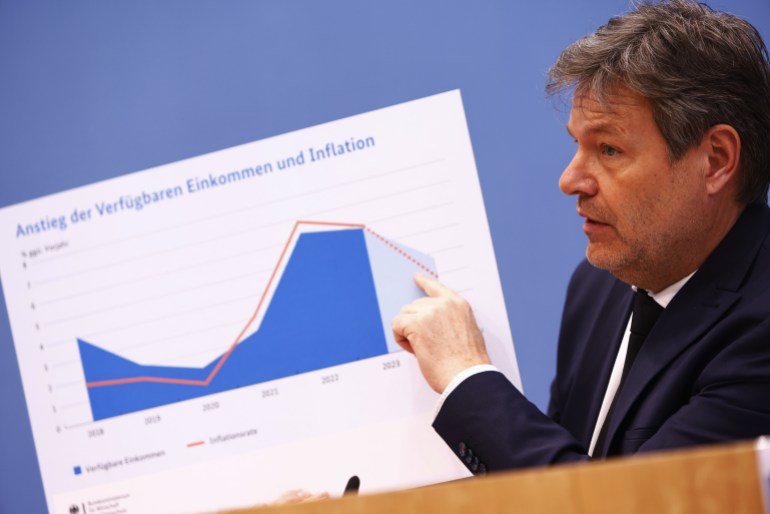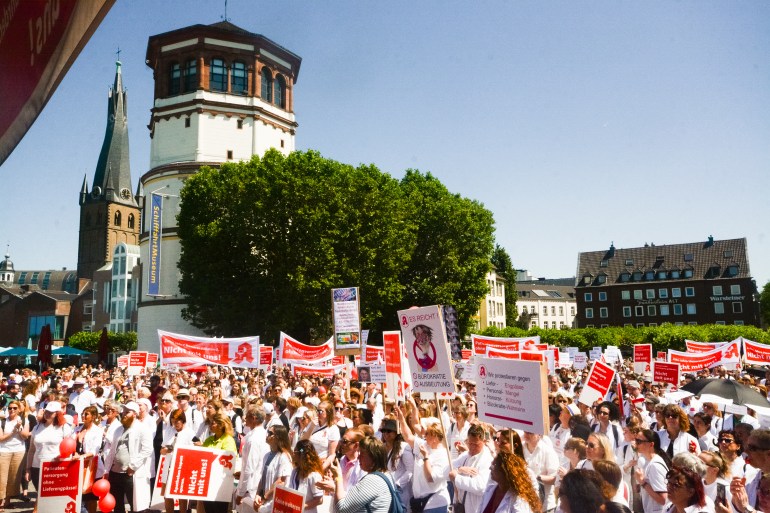Germany, Europe’s industrial powerhouse, is combating a important labour scarcity. By some estimates, two million jobs throughout the economic system are vacant, and half of the nation’s firms are unable to search out sufficient employees.
Faced with this disaster, dozens of companies are testing a method that, on the floor, at the very least, would possibly seem counterintuitive: getting employees to work fewer days.
In early February, 31 firms in Germany started a “four-day” work week pilot. The initiative is being led by not-for-profit firm, 4 Day Week Global (4DWG), and administration consultancy, Intraprenör. Another 14 firms are becoming a member of the initiative in March.
The German public analysis college, University of Münster, will perform a scientific analysis of the six-month-long trials, during which as much as 600 staff are anticipated to take part.
The 4DWG, which has been conducting related trials in lots of different international locations, believes that lowering work days, whereas protecting pay on the similar ranges, would end in productiveness features for firms and improved wellbeing of staff, motivating a stretched workforce. The strategy may additionally appeal to folks to the workforce who can’t work 5 days every week, serving to ease the labour crunch.
But how is the German experiment completely different from a sequence of efforts in different international locations to check a shorter work-week? What have these earlier trials proven – are employees extra productive after they work fewer hours? Is it potential for the worldwide economic system to shift to a four-day work week, and can different international locations observe the lead? Al Jazeera spoke to economists, specialists and researchers concerned within the examine to search out out.
The brief reply: The German take a look at makes use of extra refined strategies to match extra sturdy information than earlier trials in different international locations, say economists, specialists and researchers, although it nonetheless has shortcomings. Its outcomes may provide the clearest image but of the features and pitfalls of a four-day week. But even the staunchest advocates for the technique concede that shifting all jobs to a shorter work week might not be potential.

The lengthy historical past of the brief work week debate
The demand for a work-life stability emerged from the commerce union motion in elements of the world within the nineteenth century that campaigned for eight hours of labor, eight hours of recreation and eight hours of relaxation.
Then, the trendy economic system noticed its first full take a look at of a shorter work week. Timothy T Campbell, a senior lecturer in company social duty and enterprise ethics on the United Kingdom-based De Montfort University, traced the origins of a decreased work week to the Forties when drivers of gas and gasoline supply vehicles within the United States labored 4 days every week.
In the a long time that adopted, particularly because the Nineteen Sixties, a number of four-day week experiments had been performed, Campbell concluded in a analysis paper.
“But it was in the early 1970s that interest in the 4DWW (four-day work week) exploded, almost exclusively in the US, in both the popular press and academia,” the examine discovered. “It did not last. By the end of the 1970s very little interest remained.”
Back then, the most well-liked method of making an attempt out a four-day work week, which was examined in numerous sectors of the economic system, together with manufacturing, was to work 10 hours a day for 4 days every week.
“While there were reported advantages such as improved morale, job satisfaction, decreased absenteeism and so on, there was also evidence of increased monitoring by employers and intensified work (due to prolonged daily hours), which could lead to more stress rather than less,” Campbell instructed Al Jazeera.
Today, the imply weekly hours that an individual across the globe works for stands at 44 hours, in accordance with the International Labour Organization’s World Employment and Social Outlook report printed in January. Different international locations have their very own legal guidelines capping most each day work, past which employees are entitled to time beyond regulation pay.
An earlier ILO report famous that the typical hours of labor per week was the best in South Asia (49 hours), adopted by Eastern Asia (48.8 hours) and the bottom in North America (36 hours) and Northern, Southern and Western Europe (37.2 hours).
Around the world, one in three folks labored what are thought-about to be lengthy working hours – 48 hours every week – earlier than the COVID-19 pandemic. In some international locations like India, a majority of employees clocked lengthy hours. Only one-fifth of staff across the globe labored lower than 35 hours every week.

‘A paradox’
The underlying assumption of the decreased working hours trial, stated Julia Backmann, professor and chair for a workforce wanting on the transformation of labor on the University of Münster, is that with fewer working hours, employees could have extra time to get better from work.
This, in accordance with the speculation of the specialists who’ve designed the experiment, may assist employees focus extra after they return to their jobs. Backmann is on 4DWG’s analysis workforce and is concerned with the German trials.
Trial advocates stated that one of many principal targets is addressing the labour scarcity within the German economic system by attracting employees in direction of firms with higher work-life stability. They stated that it could profit firms, particularly in sectors akin to healthcare and training, the place the pay is relatively much less engaging, or industries akin to legislation or data know-how, the place the competitors for attracting employees is excessive.
“It’s kind of a paradox. If you ask politicians, when it comes to labour shortage, they would say ‘everyone has to work more hours and not less’,” Carsten Meier, co-founder and associate at Intraprenör, the Berlin-based consultancy concerned within the trials, instructed Al Jazeera in an interview, “A four-day work week is an attractive concept to solve labour shortage as it makes it easier for companies to gain more attraction with the right talent. That’s the main objective of the participating companies.”
German economic system minister Robert Habeck not too long ago stated that the most important hurdle in the way in which of the nation’s financial progress can be the labour scarcity. He put the estimated determine of job vacancies at two million, even because the estimated expert employees stage is predicted to go as much as 5 million by 2035 in Germany.
Meier stated that the four-day work week is predicted to have optimistic results on each the psychological and bodily wellbeing of staff, which can cut back sick go away, as it’ll go away extra room for leisure and bodily actions. “For instance, men would be more present towards caretaking activities towards their children or elderly people, helping women to get into more types of full-time work, which will also address the labour shortage,” he stated.
Germany misplaced about 26 billion euros ($28.5bn) of financial worth in 2023 attributable to excessive ranges of sick go away – among the many highest in developed international locations, in accordance with vfa, the nation’s research-based affiliation of pharmaceutical firms.
UK-based analysis group Autonomy and the 4DWG discovered encouraging ends in the “world’s largest” six-month trials that passed off within the United Kingdom in 2022, with 2,900 employees taking part from 61 firms. The trials noticed a 65 per cent discount in absenteeism, attributable to sickness and private go away, and decreased ranges of stress and burnout, whereas there was no impact on firm revenues. However, the trials additionally noticed staff reporting greater work depth. One 12 months on, 9 out of 10 firms are persevering with with a four-day work week, whereas half of the companies have made the four-day work week everlasting.

Designing a four-day work week
The German trials have been designed flexibly protecting in thoughts the differing wants of varied sectors.
“Our principle is based on a 100-80-100 rule, a productivity-focussed meaningful reduction in work time, which means 100 percent pay for 80 percent time and 100 percent productivity,” Charlotte Lockhart, managing director and founding father of 4DWG instructed Al Jazeera. “Different businesses will have different ways of doing that.”
Yet, the German experiment is extra advanced than a easy train in shrinking working hours.
Most firms taking part within the German experiment – whereas lowering weekly work hours from 40 – haven’t gone all the way down to 32, a quantity that will match a four-day work week, with eight hours a day.
“What’s required is that they reduce their working time significantly at least 10 percent (of their current weekly work time) and that the pay remains the same so there is no pay cut,” stated Backmann.
Many firms, Backmann stated, felt that lowering work hours additional can be “too much” to begin with.
Since the participation of firms is voluntary, and the phrases of the trials are versatile, some companies are giving staff a time without work throughout the week. However, by doing so, every employee could also be working additional hours on their remaining working days to get three days scheduled off from work.
The 4DWG workforce has been concerned in conducting related research in different international locations to check the “four-day” work week, together with New Zealand, the United Kingdom, the United States, Ireland and Australia. Compressed work hour experiments have been beforehand performed in Sweden, Finland, Iceland and Portugal, at the same time as labour unions have, lately, been demanding decreased work hours.
“This is done by effectively eliminating some of the unproductive activity that occurs in the workplace on a daily basis,” Andrew Barnes, co-founder of 4DWG instructed Al Jazeera. “It could be meetings, processes, attitudes, interruptions or people spending too much time on the internet, etc. There’s all sorts of things when you give people more time, then they have time to deal with those things outside the work environment.”
Lockhart stated that 90 % of the companies which have participated of their world trials to date have stayed on “some form of reduced work hour week” after the experiments. The research performed by 4DWG have proven a “25 per cent” improve in productiveness for companies, she stated.
However, impartial researchers, who’ve regarded into the findings and the methodologies of the trials performed by 4DWG and different related pilots performed in New Zealand and Iceland, have discovered many flaws, together with with pattern measurement, points with information assortment and restricted transparency in reporting the trial outcomes.

Design flaws
“There are definitely significant empirical limitations in the four-day week pilots carried out by organisations that have a clear intention to show positive results that most journalists are not taking into consideration,” Hugo Cuello, senior coverage analyst at Madrid-based Innovation Growth Lab, instructed Al Jazeera in an electronic mail.
Cuello, who wrote a analysis paper, Assessing the Validity of Four-day Week Pilots final 12 months, discovered key issues. In such experiments, firms determine to participate within the trial voluntarily and usually are not chosen on a randomised foundation, which makes the examine non-representative throughout the economic system.
Cuello famous that the trials additionally overrelied on self-reported information from staff asking them questions on their wellbeing or productiveness earlier than, halfway and after the experiment.
The downside of relying an excessive amount of on self-reporting is that it may result in a phenomenon often known as the Hawthorne impact. This mainly implies that staff, being conscious that they’re underneath statement throughout the short-term trials, might report optimistic results with the hope that it may result in permanency in work hour reductions.
There are challenges, too, that analysis into earlier four-day work week trials has thrown up.
As the compressed work week might result in longer working hours in a day, regardless of a time without work, some researchers have reported fatigue and stress amongst staff, at the same time as others discovered proof of decreased stress.
Cuello’s analysis additionally confirmed how the four-day work trials tried to ascertain a correlation between decreased working hours and elevated productiveness or wellbeing of staff over the trial interval with out contemplating different components that could possibly be at play.
As a part of the trials, the advocacy teams collected information on key efficiency indicators from firms and in contrast it with a interval a 12 months earlier. However, they didn’t essentially think about different exterior components which may have been at play, affecting productiveness earlier than the trial interval started, akin to climate extremities or the COVID-19 pandemic.

Overcoming obstacles
That’s the place the German trials could possibly be completely different.
The experiment is trying to beat among the limitations noticed within the earlier trials by accumulating “more objective data”, wanting past the self-reported information, Backmann stated.
The researchers will acquire hair samples of staff to find out the extent of cortisol of their physique earlier than, throughout and after the trial interval – which can in flip be used to measure stress ranges and the way and if they alter.
About 200 employees can even put on health trackers all through the trial interval, which might be used to measure different well being parameters akin to coronary heart fee, sleeping patterns and exercise ranges. However, the Hawthorne impact can’t be fully dominated out even on this case as staff who’re conscious they’re being monitored would possibly, as an illustration, have interaction in elevated bodily exercise, Backmann admitted. Since the trials additionally started in winter and would finish in summer time, seasonal change may additionally have an effect on the psychological well being of employees, she stated.
However, to regulate for social desirability results – in less complicated phrases, to make sure staff don’t report being much less pressured as a part of the trial expectations – the researchers would additionally acquire data from a management group of organisations which is not going to cut back working hours. Employees in these organisations would additionally put on health trackers and full brief surveys.
The survey will observe worker persona traits over the six-month trial interval to verify whether or not they reported a big behaviour change. “This would give us an indication whether the response of employees to the survey are completely truthful as there shouldn’t ideally be a big change in their personality reported over six months,” Backmann stated.
Already, some limitations are clear, although.
Lonnie Golden, professor of economics and labour at Penn State University, stated that retail, manufacturing and building sectors, the place sometimes hours of employees are longer, have discovered it laborious to modify to a four-day work week. There was extra acceptance in different sectors, Golden, an advisory council member at WorkFour, a non-profit arrange in partnership with 4DWG, instructed Al Jazeera.
For now, the German trial researchers hope to report again goal outcomes later this 12 months. And if the information is grim, they’ll nonetheless be upfront about it, stated Backmann. “I’m not of the opinion that every organisation should now switch to a four-hour work week,” Backmann stated. “If we see critical aspects or negative effects, I’m happy to also share them.”
https://www.aljazeera.com/economy/2024/3/9/will-a-four-day-work-week-solve-germanys-labour-shortage?traffic_source=rss


